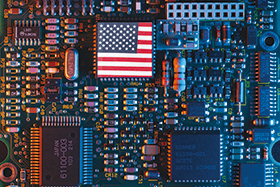The CHIPS act is a big deal
28 September 2022
Editor's Choice

Recently, the CHIPS and Science Act was signed into US law, a $280 billion bill that paves the way for new chip foundries to be built on US soil.
Recently, the CHIPS and Science Act was signed into US law, a $280 billion bill that paves the way for new chip foundries to be built on US soil. This is a significant investment in the US semiconductor industry with $52 billion specifically targeting manufacturing and research, the repercussions thereof due to be felt in all parts of the globe.
The recent global pandemic showed us a few painful weaknesses of the globalisation that the world is currently facing. Shortages of components and rising prices were rife as demand outstripped supply. The new CHIPS Act seeks to address these shortfalls by allowing eggs to be spread over many baskets.
Right now, a large proportion of chip manufacturing takes place in East Asia.
Before the pandemic, this system worked relatively smoothly with no one caring that the company designing the products were far removed from the companies actually manufacturing those products. But after the introduction of COVID and the supply chain disruptions that it caused, many components were simply not available which caused a world-wide shortage. In a nutshell, when countries in the East Asia region get a cold, the rest of the engineering world suffers as well.
If the CHIPS Act does its job, more semiconductors will be manufactured on US soil which means that a major global event or even political uncertainty in a specific region will hopefully not cause a similar shortage to the one recently seen. Although seeing US-based semiconductor foundries are still a few years off, what is more exciting is that a large proportion of the funds (around $13 billion) are dedicated not to the building of these foundries, but rather to R&D; and addressing supply chain concerns. Much of these funds will be channelled into research in quantum information science, artificial intelligence, cybersecurity and advanced communication technologies.
Further to this, another $10 billion has been earmarked for the creation of innovation and technology hubs to help spur on the generation of technology hotspots. In fact, only about 20% of the total funds set aside by the CHIPS Act focuses on chip manufacturing. A huge portion of the funds seeks to revitalise scientific research and development.
Education has not been overlooked either. Around $13 billion has been set aside to aide students in the STEM fields of study ranging from school level, through college to graduate studies. This is vital if a qualified workforce is to be available to work in these design and manufacturing companies in the next decade onwards.
This investment will have a positive spinoff, not only for the design and manufacturing companies involved, but also for every common person worldwide who enjoys the benefit of this new digital age. Let’s hope that the implementation of this Act will not slow down due to bureaucracy and red tape.
Further reading:
Could the EU’s Cyber Resilience Act affect your electronics manufacturing business?
Altron Arrow
Editor's Choice
South African companies exporting IoT devices to the European Union face a significant regulatory shift with the Cyber Resilience Act becoming mandatory in December 2027.
Read more...
From the editor's desk: Resilience and innovation in South Africa’s electronics sector
Technews Publishing
Editor's Choice
For South Africa in particular, 2025 has been a year that highlighted the resilience and adaptability of our engineering community as we navigated shifting technologies and a fast-moving international landscape
Read more...
Powering the future of embedded control
Altron Arrow
Editor's Choice DSP, Micros & Memory
As the demand for intelligent, connected, and energy-efficient systems grows, embedded engineers are under pressure to design faster, smarter, and more secure products
Read more...
Is it time for Wi-Fi 7 in SA?
Technews Publishing
Editor's Choice Telecoms, Datacoms, Wireless, IoT
Wi-Fi 7, the IEEE 802.11be standard also known as Extremely High Throughput, is the next-gen wireless networking standard designed to dramatically improve speed, latency, efficiency, and reliability.
Read more...
20 years of precision, progress and purpose – the Jemstech journey
Jemstech
Editor's Choice Manufacturing / Production Technology, Hardware & Services
Twenty years ago, Jemstech began as a small, determined venture built on technical excellence and trust. Today, it stands among South Africa’s leading electronic manufacturing service providers.
Read more...
A new era in wire bond inspection
Techmet
Editor's Choice Manufacturing / Production Technology, Hardware & Services
Viscom is developing a 3D wire bond inspection system that incorporates substantially improved sensors, a high image resolution, and fast image data processing.
Read more...
Energy harvesting using a battery-less IoT system
NuVision Electronics
Editor's Choice Power Electronics / Power Management
Energy Harvesting plays an essential role in the foundation of ambient IoT, a new generation of ultra-low power connected devices that operate by drawing energy from their environment instead of relying on traditional batteries.
Read more...
Questing for the quantum AI advantage
Editor's Choice AI & ML
Two quantum experts disclose high hopes and realities for this emerging space.
Read more...
From the editor's desk: Progress meets reality
Technews Publishing
Editor's Choice
In the first half of 2025, renewable energy, incorporating solar, wind, and to a lesser degree hydropower and bioenergy, has generated more electricity globally than coal did.
Read more...
From ER to effortless: The 15-year journey of Seven Labs Technology
Seven Labs Technology
Editor's Choice Manufacturing / Production Technology, Hardware & Services
What started as a business likened to an ‘ER’ for electronic components has today grown into a trusted partner delivering kitting services and full turnkey solutions – taking the effort out of electronics and helping customers truly ‘Move to Effortless.’
Read more...


